Hair
Everything You Need to Know About Stress-Related Hair LossIt's time to take your (hair) power back |
A quick recap on how hair works Hair typically grows in three phases: anagen (hair growth), catagen (a "resting" phase), and telogen (shedding). According to our derms, on a typical scalp 80-90 percent of the hairs on your head are in the anagen — or growth — phase at any given time, with 10-20 percent of hairs in either catagen or telogen phases. "It's normal to shed about 100 hairs a day," explains Dr. Gohara. So, that accounts for most of the hair we normally see in our brush or the shower drain.
But when stress takes its toll, it propels hairs normally in the growth phase into the shedding phase, which means profuse amounts of hair starts falling out, a condition known as telogen effluvium. There: your new hair nemesis now has a name.
Image via Veronique Beranger/Getty
SEE NEXT PAGE: Why does this happen?
But when stress takes its toll, it propels hairs normally in the growth phase into the shedding phase, which means profuse amounts of hair starts falling out, a condition known as telogen effluvium. There: your new hair nemesis now has a name.
Image via Veronique Beranger/Getty
SEE NEXT PAGE: Why does this happen?































